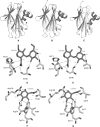The liverwort Marchantia polymorpha expresses orthologs of the fungal Agaricus bisporus agglutinin family
- PMID: 17041032
- PMCID: PMC1914199
- DOI: 10.1104/pp.106.087437
The liverwort Marchantia polymorpha expresses orthologs of the fungal Agaricus bisporus agglutinin family
Abstract
A lectin different from the previously described mannose-binding agglutinins has been isolated from the liverwort Marchantia polymorpha. Biochemical characterization of the purified lectin combined with the data from earlier transcriptome analyses demonstrated that the novel M. polymorpha agglutinin is not related to any of the known plant lectin families, but closely resembles the Agaricus bisporus-type lectins, which hitherto have been found exclusively in fungi. Immunolocalization studies confirmed that lectin is exclusively associated with plant cells, ruling out the possibility of a fungal origin. Extensive screening of publicly accessible databases confirmed that, apart from fungi, the occurrence of A. bisporus-type lectins is confined to M. polymorpha and the moss Tortula ruralis. Expression of a typical fungal protein in a liverwort and a moss raises the question of the origin of the corresponding genes. Regardless of the evolutionary origin, the presence of a functional A. bisporus lectin ortholog in M. polymorpha provides evidence for the expression of an additional carbohydrate-binding domain in Viridiplantae.
Figures




References
-
- Adam KP, Becker H (1993) A lectin from the liverwort Marchantia polymorpha L. Experientia 49 1098–1100 - PubMed
-
- Bochner BS, Alvarez RA, Mehta P, Bovin NV, Blixt O, White JR, Schnaar RL (2005) Glycan array screening reveals a candidate ligand for Siglec-8. J Biol Chem 280 4307–4312 - PubMed
-
- Carrizo ME, Capaldi S, Perduca M, Irazoqui FJ, Nores GA, Monaco HL (2005) The antineoplastic lectin of the common edible mushroom (Agaricus bisporus) has two binding sites, each specific for a different configuration at a single epimeric hydroxyl. J Biol Chem 280 10614–10623 - PubMed
-
- Czapla TH, Lang BA (1990) Effect of plant lectins on the larval development of European corn borer (Lepidoptera pyralidae) and southern corn rootworm (Coleoptera chrysomelidae). J Econ Entomol 83 2480–2485
Publication types
MeSH terms
Substances
Associated data
- Actions
- Actions
- Actions
- Actions
- Actions
- Actions
- Actions
Grants and funding
LinkOut - more resources
Full Text Sources
Other Literature Sources

